Getting Started Guide¶
This guide will help you get started with ACRN. We’ll show how to prepare a build environment on your development computer. Then we’ll walk through the steps to set up a simple ACRN configuration on a target system. The configuration is based on the ACRN predefined industry scenario and consists of an ACRN hypervisor, Service VM, and one User VM, as illustrated in this figure:
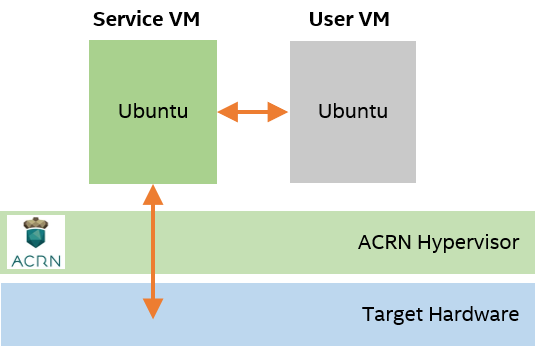
Throughout this guide, you will be exposed to some of the tools, processes, and components of the ACRN project. Let’s get started.
Prerequisites¶
You will need two machines: a development computer and a target system. The development computer is where you configure and build ACRN and your application. The target system is where you deploy and run ACRN and your application.

Before you begin, make sure your machines have the following prerequisites:
Development computer:
Hardware specifications
A PC with Internet access (A fast system with multiple cores and 16MB memory or more will make the builds go faster.)
Software specifications
Ubuntu Desktop 18.04 or newer (ACRN development is not supported on Windows.)
Target system:
Hardware specifications
Target board (see Tested Platforms by ACRN Release)
Ubuntu 18.04 Desktop bootable USB disk: download the Ubuntu 18.04.05 Desktop ISO image and follow the Ubuntu documentation for instructions for creating the USB disk.
USB keyboard and mouse
Monitor
Ethernet cable and Internet access
Serial-to-USB cable to view the ACRN and VM console (optional)
A second USB disk with minimum 1GB capacity to copy files between the development computer and target system
Local storage device (NVMe or SATA drive, for example)
Set Up the Hardware¶
To set up the hardware environment:
Connect the mouse, keyboard, monitor, and power supply cable to the target system.
Connect the target system to the LAN with the Ethernet cable.
(Optional) Connect the serial cable between the target and development computer to view the ACRN and VM console (for an example, see Enable Serial Port on NUC).
Example of a target system with cables connected:
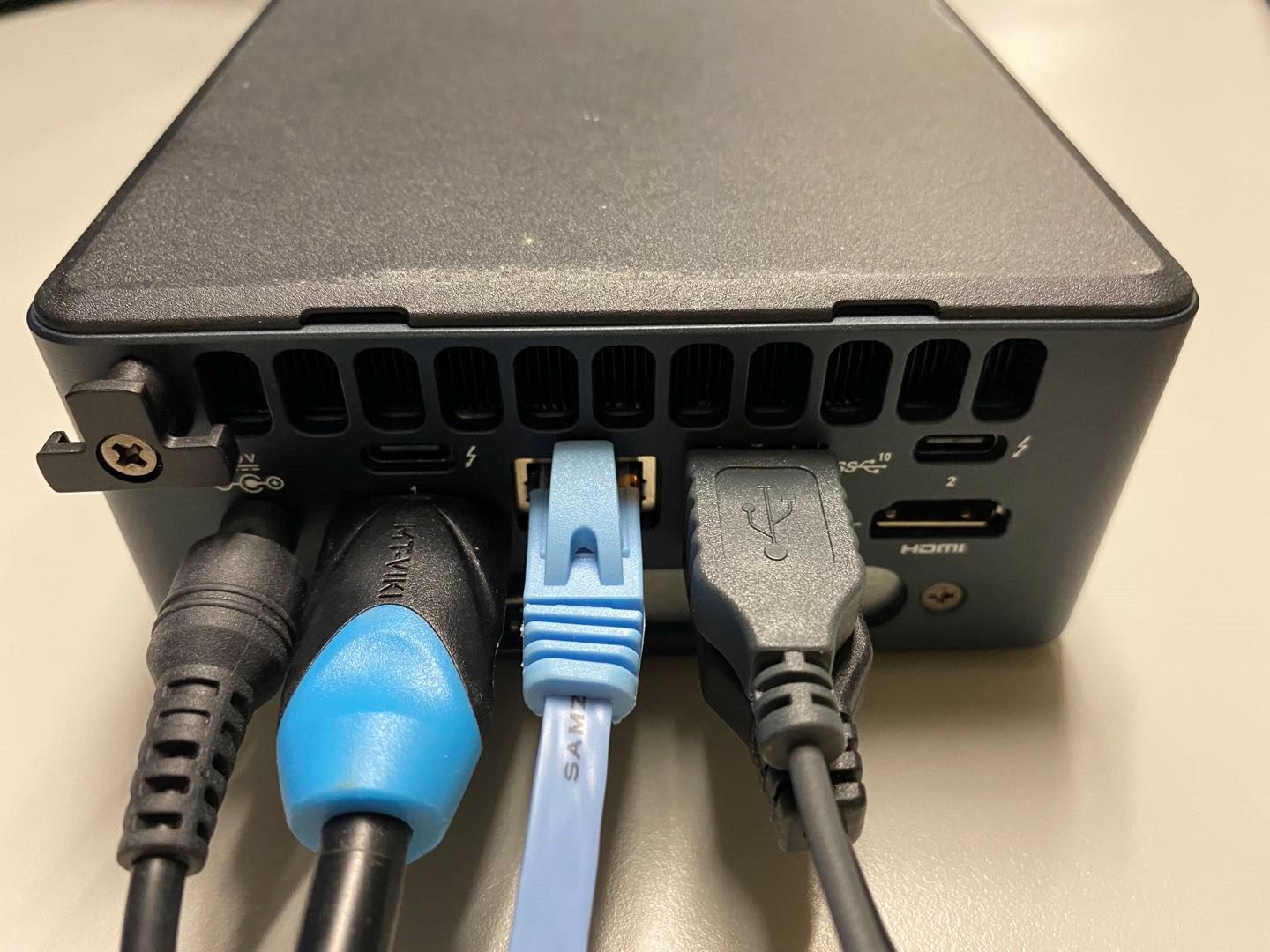
Prepare the Development Computer¶
To set up the ACRN build environment on the development computer:
On the development computer, run the following command to confirm that Ubuntu Desktop 18.04 or newer is running:
cat /etc/os-release
If you have an older version, see Ubuntu documentation to install a new OS on the development computer.
Update Ubuntu with any outstanding patches:
sudo apt update
Followed by:
sudo apt upgrade -y
Install the necessary ACRN build tools:
sudo apt install gcc \ git \ make \ vim \ libssl-dev \ libpciaccess-dev \ uuid-dev \ libsystemd-dev \ libevent-dev \ libxml2-dev \ libxml2-utils \ libusb-1.0-0-dev \ python3 \ python3-pip \ libblkid-dev \ e2fslibs-dev \ pkg-config \ libnuma-dev \ liblz4-tool \ flex \ bison \ xsltproc \ clang-format \ bc
Install Python package dependencies:
sudo pip3 install lxml xmlschema defusedxml
Install the iASL compiler/disassembler used for advanced power management, device discovery, and configuration (ACPI) within the host OS:
mkdir ~/acrn-work cd ~/acrn-work wget https://acpica.org/sites/acpica/files/acpica-unix-20210105.tar.gz tar zxvf acpica-unix-20210105.tar.gz cd acpica-unix-20210105 make clean && make iasl sudo cp ./generate/unix/bin/iasl /usr/sbin
Get the ACRN hypervisor and kernel source code. (Note these checkout tags will be updated when we launch the v2.6 release):
cd ~/acrn-work git clone https://github.com/projectacrn/acrn-hypervisor cd acrn-hypervisor git checkout v2.6 cd .. git clone https://github.com/projectacrn/acrn-kernel cd acrn-kernel git checkout release_2.6
Prepare the Target and Generate a Board Configuration File¶
A board configuration file is an XML file that stores hardware-specific information extracted from the target system. The file is used to configure the ACRN hypervisor, because each hypervisor instance is specific to your target hardware.
You use the board inspector tool to generate the board configuration file.
Important
Whenever you change the configuration of the board, such as BIOS settings, additional memory, or PCI devices, you must generate a new board configuration file.
Install OS on the Target¶
The target system needs Ubuntu 18.04 to run the board inspector tool.
To install Ubuntu 18.04:
Insert the Ubuntu bootable USB disk into the target system.
Power on the target system, and select the USB disk as the boot device in the UEFI menu. Note that the USB disk label presented in the boot options depends on the brand/make of the USB drive. (You will need to configure the BIOS to boot off the USB device first, if that option isn’t available.)
After selecting the language and keyboard layout, select the Normal installation and Download updates while installing Ubuntu (downloading updates requires the target to have an Internet connection).
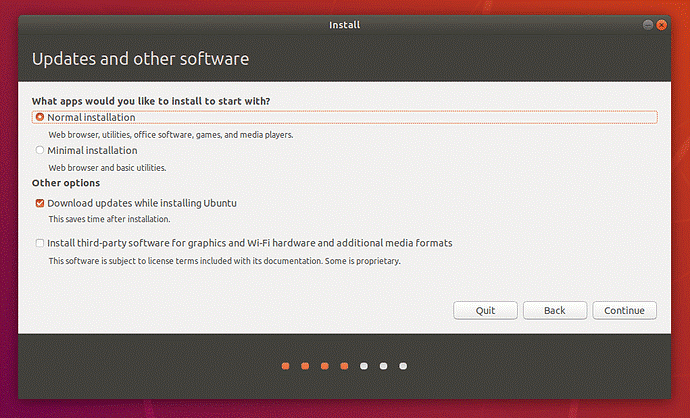
Use the checkboxes to choose whether you’d like to install Ubuntu alongside another operating system, or delete your existing operating system and replace it with Ubuntu:

Complete the Ubuntu installation and create a new user account
acrnand set a password.The next section shows how to configure BIOS settings.
Configure Target BIOS Settings¶
Boot your target and enter the BIOS configuration editor.
Tip: When you are booting your target, you’ll see an option (quickly) to enter the BIOS configuration editor, typically by pressing F2 during the boot and before the GRUB menu (or Ubuntu login screen) appears.
Configure these BIOS settings:
Enable VMX (Virtual Machine Extensions, which provide hardware assist for CPU virtualization).
Enable VT-d (Intel Virtualization Technology for Directed I/O, which provides additional support for managing I/O virtualization).
Disable Secure Boot. This simplifies the steps for this example.
The names and locations of the BIOS settings differ depending on the target hardware and BIOS version. You can search for the items in the BIOS configuration editor.
For example, on a Tiger Lake NUC, quickly press F2 while the system is booting. (If the GRUB menu or Ubuntu login screen appears, press CTRL + ALT + DEL to reboot again and press F2 sooner.) The settings are in the following paths:
System Agent (SA) Configuration > VT-d > Enabled
CPU Configuration > VMX > Enabled
Boot > Secure Boot > Secure Boot > Disabled
Set other BIOS settings, such as Hyper-Threading, depending on the needs of your application.
Generate a Board Configuration File¶
On the target system, install the board inspector dependencies:
sudo apt install cpuid msr-tools pciutils dmidecode python3 python3-pip
Install the Python package dependencies:
sudo pip3 install lxml
Configure the GRUB kernel command line as follows:
Edit the
grubfile. The following command usesvi, but you can use any text editor.sudo vi /etc/default/grub
Find the line starting with
GRUB_CMDLINE_LINUX_DEFAULTand append:idle=nomwait iomem=relaxed intel_idle.max_cstate=0 intel_pstate=disable
Example:
GRUB_CMDLINE_LINUX_DEFAULT="quiet splash idle=nomwait iomem=relaxed intel_idle.max_cstate=0 intel_pstate=disable"
These settings allow the board inspector tool to gather important information about the board.
Save and close the file.
Update GRUB and reboot the system:
sudo update-grub reboot
Copy the board inspector tool folder from the development computer to the target via USB disk as follows:
Move to the development computer.
On the development computer, insert the USB disk that you intend to use to copy files.
Ensure that there is only one USB disk inserted by running the following command:
ls /media/$USERConfirm that one disk name appears. You’ll use that disk name in the following steps.
Copy the board inspector tool folder from the acrn-hypervisor source code to the USB disk:
cd ~/acrn-work/ disk="/media/$USER/"$(ls /media/$USER) cp -r acrn-hypervisor/misc/config_tools/board_inspector/ $disk/ sync && sudo umount $disk
Insert the USB disk into the target system.
Copy the board inspector tool from the USB disk to the target:
mkdir -p ~/acrn-work disk="/media/$USER/"$(ls /media/$USER) cp -r $disk/board_inspector ~/acrn-work
On the target, load the
msrdriver, used by the board inspector:sudo modprobe msr
Run the board inspector tool (
board_inspector.py) to generate the board configuration file. This example uses the parametermy_boardas the file name.cd ~/acrn-work/board_inspector/ sudo python3 board_inspector.py my_boardConfirm that the board configuration file
my_board.xmlwas generated in the current directory.Copy
my_board.xmlfrom the target to the development computer via USB disk as follows:Make sure the USB disk is connected to the target.
Copy
my_board.xmlto the USB disk:disk="/media/$USER/"$(ls /media/$USER) cp ~/acrn-work/board_inspector/my_board.xml $disk/ sync && sudo umount $disk
Insert the USB disk into the development computer.
Copy
my_board.xmlfrom the USB disk to the development computer:disk="/media/$USER/"$(ls /media/$USER) cp $disk/my_board.xml ~/acrn-work sudo umount $disk
Generate a Scenario Configuration File and Launch Script¶
You use the ACRN configurator to generate scenario configuration files and launch scripts.
A scenario configuration file is an XML file that holds the parameters of a specific ACRN configuration, such as the number of VMs that can be run, their attributes, and the resources they have access to.
A launch script is a shell script that is used to create a User VM.
To generate a scenario configuration file and launch script:
On the development computer, install ACRN configurator dependencies:
cd ~/acrn-work/acrn-hypervisor/misc/config_tools/config_app sudo pip3 install -r requirementsLaunch the ACRN configurator:
python3 acrn_configurator.py
Your web browser should open the website http://127.0.0.1:5001/ automatically, or you may need to visit this website manually. The ACRN configurator is supported on Chrome and Firefox.
Click the Import Board info button and browse to the board configuration file
my_board.xmlpreviously generated. When it is successfully imported, the board information appears. Example: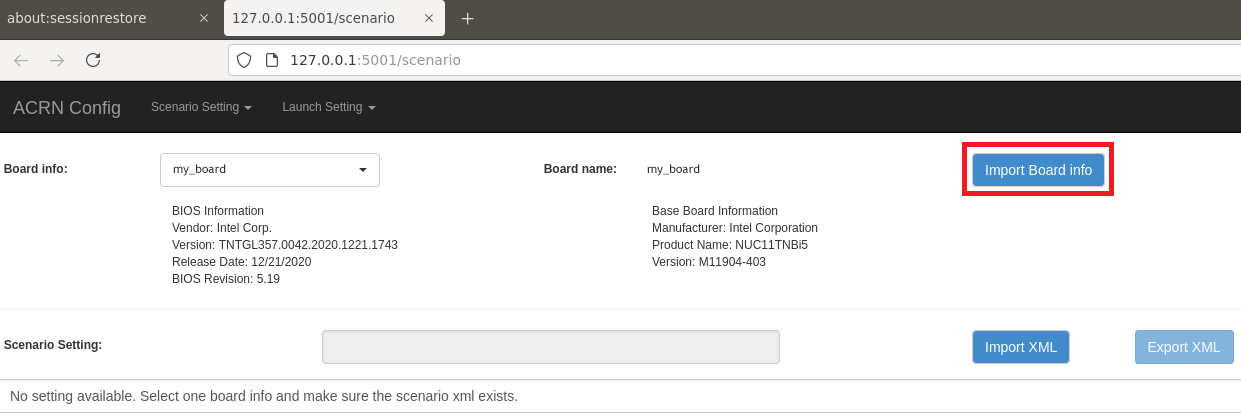
Generate the scenario configuration file:
Click the Scenario Setting menu on the top banner of the UI and select Load a default scenario. Example:
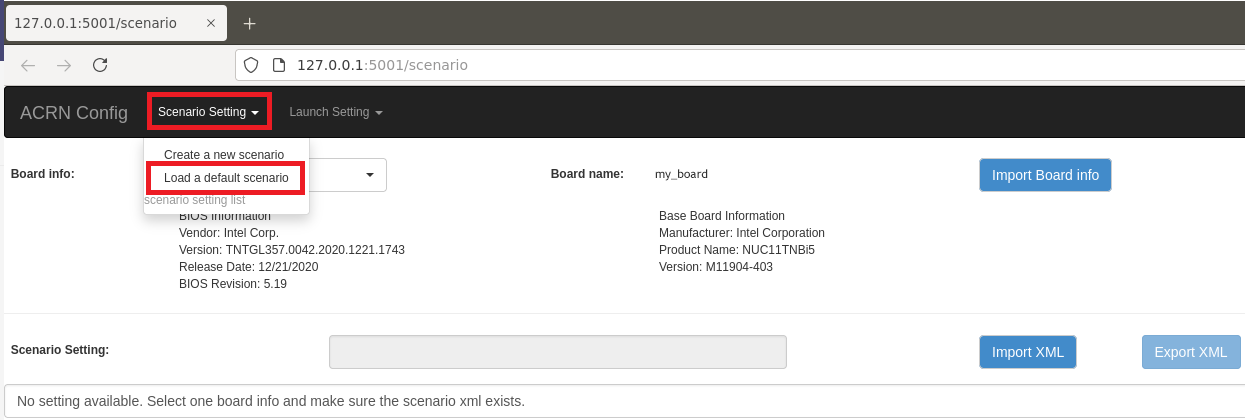
In the dialog box, select industry as the default scenario setting and click OK.

The scenario’s configurable items appear. Feel free to look through all the available configuration settings used in this sample scenario. This is where you can change the sample scenario to meet your application’s particular needs. But for now, leave them as they’re set in the sample.
Click the Export XML button to save the scenario configuration file that will be used in the build process.
In the dialog box, keep the default name as is. Type
/home/<username>/acrn-workin the Scenario XML Path field. In the following example, acrn is the username. Click Submit to save the file.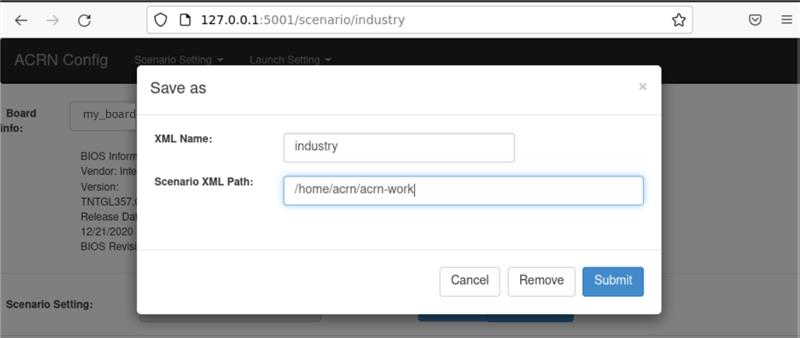
Confirm that
industry.xmlappears in the directory/home/<username>/acrn-work.
Generate the launch script:
Click the Launch Setting menu on the top banner of the UI and select Load a default launch script.
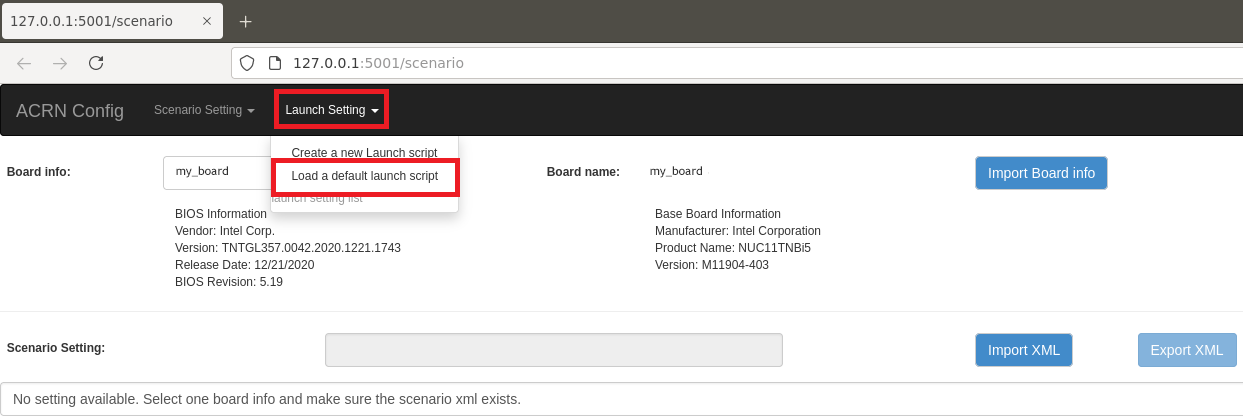
In the dialog box, select industry_launch_6uos as the default launch setting and click OK.
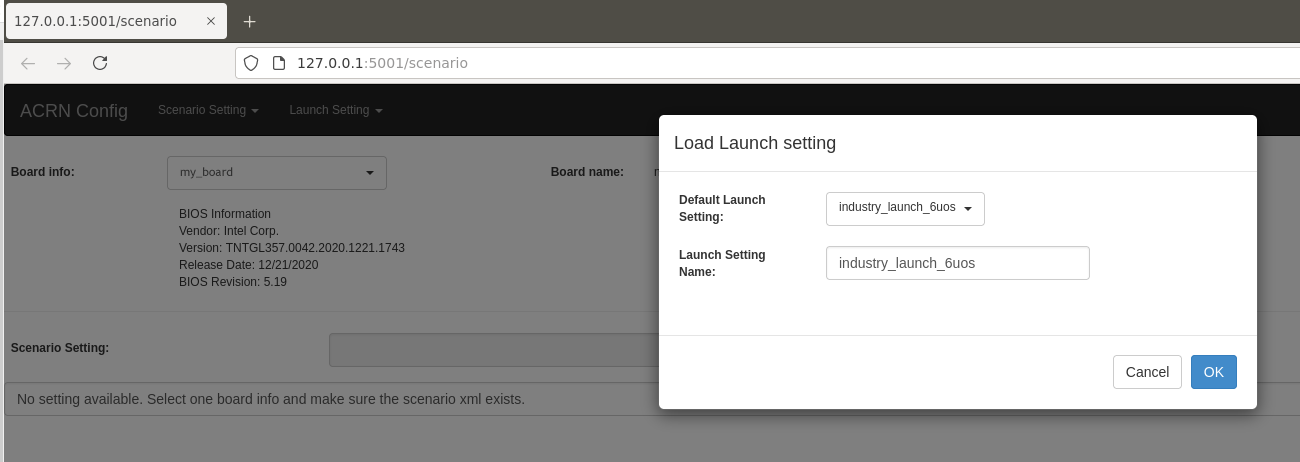
Click the Generate Launch Script button.

In the dialog box, type
/home/<username>/acrn-work/in the Source Path field. In the following example,acrnis the username. Click Submit to save the script.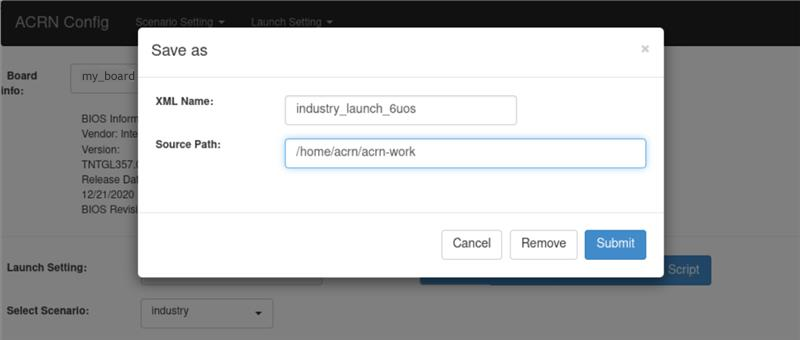
Confirm that
launch_uos_id3.shappears in the directory/home/<username>/acrn-work/my_board/output/.
Close the browser and press CTRL + C to terminate the
acrn_configurator.pyprogram running in the terminal window.
Build ACRN¶
On the development computer, build the ACRN hypervisor:
cd ~/acrn-work/acrn-hypervisor make -j $(nproc) BOARD=~/acrn-work/my_board.xml SCENARIO=~/acrn-work/industry.xml make targz-pkg
The build typically takes a few minutes. By default, the build results are found in the build directory. For convenience, we also built a compressed tar file to ease copying files to the target.
Build the ACRN kernel for the Service VM:
cd ~/acrn-work/acrn-kernel cp kernel_config_uefi_sos .config make olddefconfig make -j $(nproc) targz-pkg
The kernel build can take 15 minutes or less on a fast computer, but could take 1-3 hours depending on the performance of your development computer.
Copy all the necessary files generated on the development computer to the target system by USB disk as follows:
Insert the USB disk into the development computer and run these commands:
disk="/media/$USER/"$(ls /media/$USER) cp linux-5.10.52-acrn-sos-x86.tar.gz $disk/ cp ~/acrn-work/acrn-hypervisor/build/hypervisor/acrn.bin $disk/ cp ~/acrn-work/my_board/output/launch_uos_id3.sh $disk/ cp ~/acrn-work/acpica-unix-20210105/generate/unix/bin/iasl $disk/ cp ~/acrn-work/acrn-hypervisor/build/acrn-2.6-unstable.tar.gz $disk/ sync && sudo umount $disk/
Insert the USB disk you just used into the target system and run these commands to copy the tar files locally:
disk="/media/$USER/"$(ls /media/$USER) cp $disk/linux-5.10.52-acrn-sos-x86.tar.gz ~/acrn-work cp $disk/acrn-2.6-unstable.tar.gz ~/acrn-work
Extract the Service VM files onto the target system:
cd ~/acrn-work sudo tar -zxvf linux-5.10.52-acrn-sos-x86.tar.gz -C / --keep-directory-symlinkExtract the ACRN tools and images:
sudo tar -zxvf acrn-2.6-unstable.tar.gz -C / --keep-directory-symlink
Copy a few additional ACRN files to the expected locations:
sudo mkdir -p /boot/acrn/ sudo cp $disk/acrn.bin /boot/acrn sudo cp $disk/iasl /usr/sbin/ cp $disk/launch_uos_id3.sh ~/acrn-work sudo umount $disk/
Install ACRN¶
In the following steps, you will configure GRUB on the target system.
On the target, find the root file system (rootfs) device name by using the
lsblkcommand:~$ lsblk NAME MAJ:MIN RM SIZE RO TYPE MOUNTPOINT loop0 7:0 0 255.6M 1 loop /snap/gnome-3-34-1804/36 loop1 7:1 0 62.1M 1 loop /snap/gtk-common-themes/1506 loop2 7:2 0 2.5M 1 loop /snap/gnome-calculator/884 loop3 7:3 0 241.4M 1 loop /snap/gnome-3-38-2004/70 loop4 7:4 0 61.8M 1 loop /snap/core20/1081 loop5 7:5 0 956K 1 loop /snap/gnome-logs/100 loop6 7:6 0 2.2M 1 loop /snap/gnome-system-monitor/148 loop7 7:7 0 2.4M 1 loop /snap/gnome-calculator/748 loop8 7:8 0 29.9M 1 loop /snap/snapd/8542 loop9 7:9 0 32.3M 1 loop /snap/snapd/12704 loop10 7:10 0 65.1M 1 loop /snap/gtk-common-themes/1515 loop11 7:11 0 219M 1 loop /snap/gnome-3-34-1804/72 loop12 7:12 0 55.4M 1 loop /snap/core18/2128 loop13 7:13 0 55.5M 1 loop /snap/core18/2074 loop14 7:14 0 2.5M 1 loop /snap/gnome-system-monitor/163 loop15 7:15 0 704K 1 loop /snap/gnome-characters/726 loop16 7:16 0 276K 1 loop /snap/gnome-characters/550 loop17 7:17 0 548K 1 loop /snap/gnome-logs/106 loop18 7:18 0 243.9M 1 loop /snap/gnome-3-38-2004/39 nvme0n1 259:0 0 119.2G 0 disk ├─nvme0n1p1 259:1 0 512M 0 part /boot/efi └─nvme0n1p2 259:2 0 118.8G 0 part /
As highlighted, you’re looking for the device name associated with the partition named
/, in this casenvme0n1p2.Run the
blkidcommand to get the UUID and PARTUUID for the rootfs device (replace thenvme0n1p2name with the name shown for the rootfs on your system):sudo blkid /dev/nvme0n1p2
In the output, look for the UUID and PARTUUID (example below). You will need them in the next step.
/dev/nvme0n1p2: UUID="3cac5675-e329-4cal-b346-0a3e65f99016" TYPE="ext4" PARTUUID="03db7f45-8a6c-454b-adf7-30343d82c4f4"Add the ACRN Service VM to the GRUB boot menu:
Edit the GRUB 40_custom file. The following command uses
vi, but you can use any text editor.sudo vi /etc/grub.d/40_custom
Add the following text at the end of the file. Replace
<UUID>and<PARTUUID>with the output from the previous step.menuentry "ACRN Multiboot Ubuntu Service VM" --id ubuntu-service-vm { load_video insmod gzio insmod part_gpt insmod ext2 search --no-floppy --fs-uuid --set "UUID" echo 'loading ACRN...' multiboot2 /boot/acrn/acrn.bin root=PARTUUID="PARTUUID" module2 /boot/vmlinuz-5.10.52-acrn-sos Linux_bzImage }
Save and close the file.
Correct example image
menuentry "ACRN Multiboot Ubuntu Service VM" --id ubuntu-service-vm { load_video insmod gzio insmod part_gpt insmod ext2 search --no-floppy --fs-uuid --set "3cac5675-e329-4cal-b346-0a3e65f99016" echo 'loading ACRN...' multiboot2 /boot/acrn/acrn.bin root=PARTUUID="03db7f45-8a6c-454b-adf7-30343d82c4f4" module2 /boot/vmlinuz-5.10.52-acrn-sos Linux_bzImage }
Make the GRUB menu visible when booting and make it load the Service VM kernel by default:
Edit the
grubfile:sudo vi /etc/default/grub
Edit lines with these settings (comment out the
GRUB_TIMEOUT_STYLEline). Leave other lines as they are:GRUB_DEFAULT=ubuntu-service-vm #GRUB_TIMEOUT_STYLE=hidden GRUB_TIMEOUT=5
Save and close the file.
Update GRUB and reboot the system:
sudo update-grub reboot
Confirm that you see the GRUB menu with the “ACRN Multiboot Ubuntu Service VM” entry. Select it and proceed to booting ACRN. (It may be autoselected, in which case it will boot with this option automatically in 5 seconds.)
GNU GRUB version 2.04 ──────────────────────────────────────────────────────────────────────────────── Ubuntu Advanced options for Ubuntu Ubuntu 18.04.05 LTS (18.04) (on /dev/nvme0n1p2) Advanced options for Ubuntu 18.04.05 LTS (18.04) (on /dev/nvme0n1p2) System setup *ACRN Multiboot Ubuntu Service VM
Run ACRN and the Service VM¶
When the ACRN hypervisor starts to boot, the ACRN console log will be displayed to the serial port (optional). The ACRN hypervisor boots the Ubuntu Service VM automatically.
On the target, log in to the Service VM. (It will look like a normal Ubuntu session.)
Verify that the hypervisor is running by checking
dmesgin the Service VM:dmesg | grep ACRNYou should see “Hypervisor detected: ACRN” in the output. Example output of a successful installation (yours may look slightly different):
[ 0.000000] Hypervisor detected: ACRN [ 3.875620] ACRNTrace: Initialized acrn trace module with 4 cpu
Launch the User VM¶
A User VM image is required on the target system before launching it. The following steps use Ubuntu:
Go to the official Ubuntu website to get an ISO format of the Ubuntu 18.04 desktop image.
Put the ISO file in the path
~/acrn-work/on the target system.
Open the launch script in a text editor. The following command uses vi, but you can use any text editor.
vi ~/acrn-work/launch_uos_id3.sh
Look for the line that contains the term
virtio-blkand replace the existing image file path with your ISO image file path. In the following example, the ISO image file path is/home/acrn/acrn-work/ubuntu-18.04.5-desktop-amd64.iso.acrn-dm -A -m $mem_size -s 0:0,hostbridge -U 615db82a-e189-4b4f-8dbb-d321343e4ab3 \ --mac_seed $mac_seed \ $logger_setting \ -s 7,virtio-blk,/home/acrn/acrn-work/ubuntu-18.04.5-desktop-amd64.iso \ -s 8,virtio-net,tap_YaaG3 \ -s 6,virtio-console,@stdio:stdio_port \ --ovmf /usr/share/acrn/bios/OVMF.fd \ -s 1:0,lpc \ $vm_name
Save and close the file.
Launch the User VM:
sudo chmod +x ~/acrn-work/launch_uos_id3.sh sudo chmod +x /usr/bin/acrn-dm sudo chmod +x /usr/sbin/iasl sudo ~/acrn-work/launch_uos_id3.sh
Confirm that you see the console of the User VM on the Service VM’s terminal (on the monitor connected to the target system). Example:
Ubuntu 18.04.5 LTS ubuntu hvc0 ubuntu login:
Log in to the User VM. For the Ubuntu 18.04 ISO, the user is
ubuntu, and there’s no password.Confirm that you see output similar to this example:
Welcome to Ubuntu 18.04.5 LTS (GNU/Linux 5.4.0-42-generic x86_64) * Documentation: https://help.ubuntu.com * Management: https://landscape.canonical.com * Support: https://ubuntu.com/advantage 0 packages can be updated. 0 updates are security updates. Your Hardware Enablement Stack (HWE) is supported until April 2023. The programs included with the Ubuntu system are free software; the exact distribution terms for each program are described in the individual files in /usr/share/doc/*/copyright. Ubuntu comes with ABSOLUTELY NO WARRANTY, to the extent permitted by applicable law. To run a command as administrator (user "root"), use "sudo <command>". See "man sudo_root" for details. ubuntu@ubuntu:~$
The User VM has launched successfully. You have completed this ACRN setup.
Next Steps¶
Configuration and Development Overview describes the ACRN configuration process, with links to additional details.